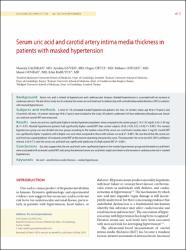| dc.contributor.author | Çalışkan, Mustafa | |
| dc.contributor.author | Güven, Aytekin | |
| dc.contributor.author | Çiftçi, Özgür | |
| dc.contributor.author | Özülkü, Mehmet | |
| dc.contributor.author | Günday, Murat | |
| dc.contributor.author | Barutçu, İrfan | |
| dc.date.accessioned | 10.07.201910:49:13 | |
| dc.date.accessioned | 2019-07-10T19:35:21Z | |
| dc.date.available | 10.07.201910:49:14 | |
| dc.date.available | 2019-07-10T19:35:21Z | |
| dc.date.issued | 2014 | en_US |
| dc.identifier.citation | Çalışkan, M., Güven, A., Çiftçi, Ö., Özülkü, M., Günday, M. ve Barutçu, İ. (2014). Serum uric acid and carotid artery intima media thickness in patients with masked hypertension. Acta Cardiologica, 69(4), 417-423. https://dx.doi.org/10.2143/AC.69.4.3036658 | en_US |
| dc.identifier.issn | 0001-5385 | |
| dc.identifier.uri | https://hdl.handle.net/20.500.12511/733 | |
| dc.identifier.uri | https://dx.doi.org/10.2143/AC.69.4.3036658 | |
| dc.description.abstract | Background: Serum uric acid is related to hypertension and cardiovascular diseases. Masked hypertension is associated with an increase in cardiovascular risk. The aim of our study was to evaluate the serum uric acid level and its relationship with carotid intima-media thickness (IMT) in patients with masked hypertension. Subjects and methods: A total of 114 untreated masked hypertension patients (62 men, 52 women; mean age 44.6 ± 7.9 years) and 38 controls (20 men, 18 women; mean age 44.8 ± 7 years) were included in the study. All patients underwent 24-hour ambulatory blood pressure. Serum uric acid and carotid IMT were measured. Results: Serum uric acid was significantly higher in masked hypertension patients when compared to the control group (5.14 ± 1.42 mg/dl, 4.84 ± 1.45 mg/dl, P = 0.01). Masked hypertension patients had significantly higher carotid IMT than control subjects (0.58 ± 0.09, 0.52 ± 0.09, P < 0.001). The masked hypertension group was also divided into two groups according to the median value of the serum uric acid levels (median value: 5 mg/dl). Carotid IMT was significantly higher in patients with a higher uric acid when compared to those with a lower uric acid (P < 0.001). We also found that the serum uric acid level was a good predictor of increased carotid IMT at the receiver-operating characteristic curve. The area under the curve was 66% (95% confidence interval, 0.56-0.77), and the serum uric acid level was significantly predictive of a high carotid IMT (P = 0.001). Conclusions: Our data suggest that the uric acid levels were significantly higher in the masked hypertension group and elevated uric acid levels were associated with increased carotid IMT, indicating that elevated serum uric acid levels might contribute to the increase in cardiovascular risk in masked hypertension. | en_US |
| dc.language.iso | eng | en_US |
| dc.publisher | Acta Cardiologica | en_US |
| dc.rights | info:eu-repo/semantics/openAccess | en_US |
| dc.subject | Uric Acid | en_US |
| dc.subject | Carotid Intima-Media Thickness | en_US |
| dc.subject | Masked Hypertension | en_US |
| dc.title | Serum uric acid and carotid artery intima media thickness in patients with masked hypertension | en_US |
| dc.type | article | en_US |
| dc.relation.ispartof | Acta Cardiologica | en_US |
| dc.department | İstanbul Medipol Üniversitesi, Tıp Fakültesi, Dahili Tıp Bilimleri Bölümü, Kardiyoloji Ana Bilim Dalı | en_US |
| dc.identifier.volume | 69 | en_US |
| dc.identifier.issue | 4 | en_US |
| dc.identifier.startpage | 417 | en_US |
| dc.identifier.endpage | 423 | en_US |
| dc.relation.publicationcategory | Makale - Uluslararası Hakemli Dergi - Kurum Öğretim Elemanı | en_US |
| dc.identifier.doi | 10.2143/AC.69.4.3036658 | en_US |
| dc.identifier.wosquality | Q4 | en_US |
| dc.identifier.scopusquality | Q3 | en_US |


















